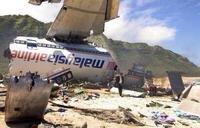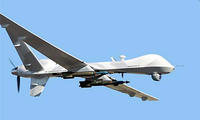-
Forensic technology could help U.S. prove case against Russia, Ukrainian separatists

Over the weekend, U.S. Secretary of State John Kerry appeared on several media outlets to make a case against Russia for the country’s support of pro-Russian separatists responsible for the downing of Malaysia Airlines Flight MH17. The United States is confident that rebels attacked the airplane with an SA-11 Gadfly 9K37M1 Buk-1M fired missile. For the United States to prove its allegations against Russia and the Ukrainian separatists, Western authorities must first gain full access to the crash site, utilize an arsenal of forensic investigative technology, then gather eye witness accounts. Once the United States can prove its allegations, European partners can then be persuaded to impose tougher sanctions on Russia.
-
-
DARPA seeks to speed new materials development process
Military platforms — such as ships, aircraft, and ground vehicles — rely on advanced materials to make them lighter, stronger, and more resistant to stress, heat, and other harsh environmental conditions. Currently, the process for developing new materials to field in platforms frequently takes more than a decade. DARPA seeks to address this problem by developing a methodology and toolset to compress the applied material development process by at least 75 percent: from an average of ten years or longer to just two and a half years.
-
-
As budget shrinks, DOD needs to rethink strategy to preserve U.S. technological edge
The United States currently accounts for less than one-third of global research and development spending, and this fraction is projected to decline to 18 percent by 2050. Those statistics, together with the recognition that the United States no longer maintains superiority across all research fields, mean that DOD’s technological leadership now depends upon its ability to identify and leverage relevant research advances as they emerge from the global science and technology enterprise, says a new report from the National Research Council.
-
-
IAF begins heavy bombardment of residential areas in north Gaza
As we predicted yesterday, the Israel Air Force (IAF) earlier this morning showered Palestinian urban areas in north Gaza with leaflets giving residents until today (Sunday) at noon (Israel time) to evacuate their homes ahead of massive Israeli bombardment of these area. The leaflets were accompanied by calls to every home phone and cell phone of residents in the area (Israel has all these phone numbers), and radio and TV broadcasts in Arabic. Hamas, in an effort to forestall the Israeli attack by keeping Palestinian civilians as a human shield, has publicly ordered the residents to stay put, branding those who leave as collaborators with the “Zionist enemy.” So far, about a third of the residents have left. Israel has just begun a heavy bombardment on the outskirts of Beit Lahia in order to remind residents that Israel is serious.
-
-
Israel launches Operation Solid Rock against Hamas (updated)
The Israeli government has launched Operation Solid Rock, authorizing the calling up 40,000 reservists as it prepares for a long campaign against Hamas, a campaign which may include land incursions into the Gaza Strip. About 10,000 are being called right away, and they will be sent to Israel’s borders in the east and north, allowing army units now stationed there to move south to engage Hamas in the south. The calling up of 10,000 reservists – about four brigades – indicates that, at this stage at least, Israel contemplates a relatively limited ground operation in Gaza. Militants in Gaza have, in the last three days, been launching nearly 100 missiles and rockets a day at Israeli cities and towns in the south of Israel, for a total of 246 missiles and rockets so far. Most of these rockets fell in empty fields. Forty-six missiles (about 27 percent of the total) were heading toward populated areas, and the IDF’s Iron Domes defense system intercepted forty of them, a 97 percent interception success rate. Six missiles managed to go through the defensive system and exploded in populated areas. During the day Tuesday, the night between Tuesday and Wednesday, and earlier this morning, the IDF has intensified its retaliatory strikes against Hamas and Islamic Jihad targets, attacking and destroying more than 450 targets across the Gaza Strip. The Israel Air Force (IAF) says that so far it has dropped more than 400 tons of explosives on targets in the Gaza Strip. The IAF says that the damage it has so far inflicted on the Gaza strip in the first two days of the current operation is greater than the damage inflicted in the eight days of Operation Pillar of Cloud (14-22 November 2012).
-
-
Pentagon should use reduced budget to prepare for "great power conflict": study
As sequestration takes toll on the Pentagon’s budget, Defense officials must decide how to maintain superior military capabilities. A new study suggests that the Pentagon should focus more on a “great power conflict,” reflective of a newly aggressive Russia and rapidly modernizing China. Such an approach would force the department to modernize its current infrastructure and invest significantly in technological advantages at the expense of unlikely-to-be used ships, aircrafts, and soldiers.
-
-
Convergence of chemistry and biology raises concerns about designer toxins
The convergence of chemistry and biology is providing major benefits to humankind, particularly in health care, alternative energy sources, and in environmental control – and when combined with other advances, particularly in nanotechnology, it is also being exploited in developing improved defensive countermeasures against chemical and biological warfare agents. This convergence, however, has also raised concerns that biotechnology could be applied to the production of new toxic chemicals, bioregulators, and toxins. A new report from OPCW says that the potential for scaling up biological processes for large scale production of chemicals of concern is still limited, but biomediated processes might still be effective for producing weaponizable quantities of toxins which are lethal to humans in microgram or lower dosage.
-
-
Military implications of advances in brain research
Researchers funded by the Pentagon’s Defense Advanced Research Projects Agency(DARPA) have developed a new way to visualize the complete brain in three-dimensional imaging. The breakthrough could advance the field of rapid brain imaging, allowing scientists to see in greater detail how parts of the brain interact on a cellular level and better understand those interactions throughout the brain. A former DARPA program manager recently told a policy group that “It turns out the expert marksman has a brain state, a state that they enter before they take the perfect shot. Can I teach a novice to create this brain state? The answer was yes.”
-
-
Drones must be used wisely to help advance U.S. interests

A new report examines three key issue sets in the unmanned aerial vehicle (UAV) debate: defense utility, national security, and economics; ethics and law; and export controls and regulatory challenges. The report concludes that UAV technologies are here to stay. Used recklessly, UAVs can endanger U.S. interests and diminish regional and global stability. Used wisely, they can help advance U.S. national security interests in the midst of a more robust global commitment to the rule of law.
-
-
Drones are cheap, soldiers are not: a cost-benefit analysis of war
Cost is largely absent in the key debates around the use of unmanned drones in war, even though drones are a cost-effective way of achieving national security objectives. Drones will never completely replace soldiers, but the drone-vs.-human being debate is becoming less important in the current strategic climate. The operating environments where drones are deployed — countries such as Pakistan, Somalia and Yemen — do not emphasize “hearts and minds” strategies where the human element has traditionally been valued as a force multiplier. Instead, objectives in these countries involve attacks on specific individuals, with operational data obtained by signal intelligence beforehand. Human contact becomes even less desirable given that a key tactic of combatants in these weak states is attrition with the aim of creating low-level civil conflicts. The end goal of these actions is to inflict high economic costs to the adversary. As a result, this remote and analytical method of engaging militarily leads to substantial cost efficiencies.
-
-
Obama administration wants $500 million to train, equip moderate Syrian rebels
The Obama administration is planning to escalate U.S. involvement in the Syrian civil war, and has asked Congress for $500 million for the U.S. military to train and equip moderate Syrian rebels. The training program would be the most significant action yet by the United States in the conflict in Syria. Yesterday’s (Thursday) request to Congress comes as the administration is looking for effective alternatives to the jihadist ISIS which is now in control of large swaths of Syria and Iraq. The $500 million request is separate from the $5 billion Counterterrorism Partnerships Fund, of which some $1.5 billion would go toward counterterrorism efforts in countries around Syria — Jordan, Lebanon, Turkey, and Iraq. The president also wants to set aside $500 million to “address unforeseen contingencies” in counterterrorism, which administration officials said was a reference to developments in Iraq.
-
-
Sandia Labs-developed IED detector being transferred to the U.S. Army
Though IED detonations have declined in Afghanistan since a peak of more than 2,000 in the month of June 2012, Department of Defense reports indicated IEDs accounted for about 60 percent of U.S. casualties that year. Detecting improvised explosive devices in Afghanistan requires constant, intensive monitoring using rugged equipment. When Sandia researchers first demonstrated a modified miniature synthetic aperture radar (MiniSAR) system to do just that, some experts did not believe it. Those early doubts, however, are gone. Sandia’s Copperhead — a highly modified MiniSAR system mounted on unmanned aerial vehicles (UAVs) — has been uncovering IEDs in Afghanistan and Iraq since 2009. Now, Sandia is transferring the technology to the U.S. Army to support combat military personnel.
-
-
OPCW says Syria has completed handover of chemical weapons, but some are skeptical
Syria handed over the remaining 100 tons of toxic material to the Organization for the Prohibition of Chemical Weapons (OPCW) last Monday. The final consignment, publicly delayed, consisted of about 8 percent of the total 1,300 tons that the country is believed to have possessed. Despite the celebratory mood, many in the West look at the Syrian and OPCW announcements skeptically due to conflicting information.
-
-
Historic proportions of Iraq’s military collapse raise questions about Iraq’s viability
“The scale of Iraq’s military collapse is of historic proportions,” one military analyst said. A recent assessment of the Iraqi military found that 60 out of 243 Iraqi Army combat battalions “cannot be accounted for, and all of their equipment is lost.” American military officials said an evaluation of the state of Iraq’s military revealed that five of the Iraqi Army’s fourteen divisions were “combat ineffective,” including the two that were overrun in Mosul. The United States has spent $1.7 trillion in Iraq since 2003, of which $25 billion were used to equip and train the post-Saddam Iraqi military. The United States received no return on its huge investment in Iraq, but it was hoped that at least the Iraqi military, U.S.-trained and U.S.-equipped, would provide a solid, professional foundation for a new Iraq. Developments in Iraq last week proved that this hope was illusory.
-
-
Engineered enzymes to neutralize deadly effects of chemical weapons
Researchers are a step closer to creating a prophylactic drug that would neutralize the deadly effects of the chemical weapons used in Syria and elsewhere. The researchers are trying to engineer enzymes — called bioscavengers — so they work more efficiently against chemical weapons.
-
More headlines
The long view
Factories First: Winning the Drone War Before It Starts
Wars are won by factories before they are won on the battlefield,Martin C. Feldmann writes, noting that the United States lacks the manufacturing depth for the coming drone age. Rectifying this situation “will take far more than procurement tweaks,” Feldmann writes. “It demands a national-level, wartime-scale industrial mobilization.”
